Dynamic Changes in Agroecosystem Landscape Patterns and Their Driving Mechanisms in Karst Mountainous Areas of Southwest China: The Case of Central Guizhou
Abstract
:1. Introduction
2. Materials and Methods
2.1. Study Area
2.2. Data Source and Processing
2.3. Research Methods
2.3.1. Selection of Typical Landscape and Determination of Transformation
2.3.2. Landscape Index Selection
2.3.3. Geodetector
3. Results
3.1. Spatial and Temporal Evolutionary Characteristics of the Overall Landscape Pattern of AES
3.2. Spatial Pattern Characteristics of AES Subsystems
3.3. Landscape Pattern Analysis of Typical Patterns of AES Transformation
3.4. Analysis of the Drivers of AES Transformation Patterns
4. Discussion
4.1. Summary of Transformation Trends and Changes in Dominant Functions of AESs in Karst Mountains
4.2. Analysis of the Transformative Effect of Karst Mountain AESs
4.3. Agricultural Policy Suggestions for the Transformation of Future Karst Mountain AESs
4.4. Limitations and Prospects
5. Conclusions
- (1)
- From 2004 to 2020, the overall landscape of AESs in the study area showed complex and diversified development, with smaller differences in CONTAG as a whole, decreasing AI in space year by year, stronger SHDI in gentle areas, and increasing ED year by year. In addition, the PLAND of each subsystem within the AES has changed significantly, with WGL showing an increasing trend in the whole area, the dominant area concentrated in the northwestern high-altitude and steep-slope area, the SCL showing a significant decreasing trend, the CL showing a trend of spreading outward with the main urban area as the center, and the EFF increasing significantly in the central part of the study area with lower altitude.
- (2)
- According to the main directions of the AES transformation, we summarized three typical transformation patterns of WGL restoration, CL growth, and EFF growth in this study. There are differences in the dominant transformation patterns on different topography. The WGL restoration mode is dominant in high-altitude areas, where the higher the altitude, the more aggregation of new WGL, the higher the fragmentation of patches, the irregular shape, and the enhanced ecological function. The low mountain areas are dominated by CL growth type, the new CL decreases with the increase in slope and elevation, and the aggregation is weakened, but its shape is regular, and the living function is enhanced. The EFF growth type dominates river valleys and hilly areas. The lower the slope and elevation, the higher the concentration of new EFF, the more concentrated and large-scale development, the more regular shape, and the significant enhancement of ecological and economic functions.
- (3)
- WGL restoration type is most influenced by slope and elevation in the transition process; CL growth type is most influenced by slope in the early period, and urbanization rate is the main influencing factor in the later transition process; EFF growth type is mainly influenced by soil organic matter, slope, and urbanization rate in the early transition period, and mainly influenced by population and urbanization rate in the later transition process. In general, socio-economic factors are the main driving force of AES transformation.
Author Contributions
Funding
Institutional Review Board Statement
Informed Consent Statement
Data Availability Statement
Conflicts of Interest
References
- Bethwell, C.; Burkhard, B.; Daedlow, K.; Sattler, C.; Reckling, M.; Zander, P. Towards an Enhanced Indication of Provisioning Ecosystemservices in Agro-Ecosystems. Environ. Monit. Assess. 2021, 193, 269. [Google Scholar] [CrossRef]
- Nadal-Romero, E.; Cammeraat, E.; Pérez-Cardiel, E.; Lasanta, T. Effects of Secondary Succession and Afforestation Practices on Soil Properties after Cropland Abandonment in Humid Mediterranean Mountain Areas. Agric. Ecosyst. Environ. 2016, 228, 91–100. [Google Scholar] [CrossRef] [Green Version]
- Kamada, M.; Nakagoshi, N. Influence of Cultural Factors on Landscapes of Mountainous Farm Villages in Western Japan. Landsc. Urban Plan. 1997, 37, 85–90. [Google Scholar] [CrossRef]
- Kassa, H.; Dondeyne, S.; Poesen, J.; Frankl, A.; Nyssen, J. Transition from Forest-Based to Cereal-Based Agricultural Systems: A Review of the Drivers of Land Use Change and Degradation in Southwest Ethiopia. Land Degrad. Dev. 2017, 28, 431–449. [Google Scholar] [CrossRef] [Green Version]
- Liang, X.; Li, Y.; Shao, J.; Ran, C. Traditional Agroecosystem Transition in Mountainous Area of Three Gorges Reservoir Area. J. Geogr. Sci. 2020, 30, 281–296. [Google Scholar] [CrossRef]
- Nair, V.D.; Nair, P.K.R.; Dari, B.; Freitas, A.M.; Chatterjee, N.; Pinheiro, F.M. Biochar in the Agroecosystem–Climate-Change–Sustainability Nexus. Front. Plant Sci. 2017, 8, 2051. [Google Scholar] [CrossRef]
- Liang, X.; Li, Y.; Ran, C.; Li, M.; Zhang, H. Study on the Transformed Farmland Landscape in Rural Areas of Southwest China: A Case Study of Chongqing. J. Rural Stud. 2020, 76, 272–285. [Google Scholar] [CrossRef]
- Long, H.; Li, Y.; Liu, Y.; Woods, M.; Zou, J. Accelerated Restructuring in Rural China Fueled by ‘Increasing vs. Decreasing Balance’ Land-Use Policy for Dealing with Hollowed Villages. Land Use Policy 2012, 29, 11–22. [Google Scholar] [CrossRef]
- Tan, M.; Li, X. The Changing Settlements in Rural Areas under Urban Pressure in China: Patterns, Driving Forces and Policy Implications. Landsc. Urban Plan. 2013, 120, 170–177. [Google Scholar] [CrossRef]
- Lu, Q.; Liang, F.; Bi, X.; Duffy, R.; Zhao, Z. Effects of Urbanization and Industrialization on Agricultural Land Use in Shandong Peninsula of China. Ecol. Indic. 2011, 11, 1710–1714. [Google Scholar] [CrossRef]
- Wenhua, L. Degradation and Restoration of Forest Ecosystems in China. For. Ecol. Manag. 2004, 201, 33–41. [Google Scholar] [CrossRef]
- Zhao, G.; Mu, X.; Wen, Z.; Wang, F.; Gao, P. Soil Erosion, Conservation, and Eco-Environment Changes in the Loess Plateau of China. Land Degrad. Dev. 2013, 24, 499–510. [Google Scholar] [CrossRef]
- Viglizzo, E.F.; Roberto, Z.E.; Filippin, M.C.; Pordomingo, A.J. Climate Variability and Agroecological Change in the Central Pampas of Argentina. Agric. Ecosyst. Environ. 1995, 55, 7–16. [Google Scholar] [CrossRef]
- Araral, E. What Makes Socio-Ecological Systems Robust? An Institutional Analysis of the 2000 Year-Old Ifugao Society. Hum. Ecol. 2013, 41, 859–870. [Google Scholar] [CrossRef]
- Enfors, E. Social–Ecological Traps and Transformations in Dryland Agro-Ecosystems: Using Water System Innovations to Change the Trajectory of Development. Glob. Environ. Chang. 2013, 23, 51–60. [Google Scholar] [CrossRef]
- Peng, J.; Tian, L.; Zhang, Z.; Zhao, Y.; Green, S.M.; Quine, T.A.; Liu, H.; Meersmans, J. Distinguishing the Impacts of Land Use and Climate Change on Ecosystem Services in a Karst Landscape in China. Ecosyst. Serv. 2020, 46, 101199. [Google Scholar] [CrossRef]
- Tong, X.; Brandt, M.; Yue, Y.; Horion, S.; Wang, K.; Keersmaecker, W.D.; Tian, F.; Schurgers, G.; Xiao, X.; Luo, Y.; et al. Increased Vegetation Growth and Carbon Stock in China Karst via Ecological Engineering. Nat. Sustain. 2018, 1, 44–50. [Google Scholar] [CrossRef]
- Verburg, P.H.; Van De Steeg, J.; Veldkamp, A.; Willemen, L. From Land Cover Change to Land Function Dynamics: A Major Challenge to Improve Land Characterization. J. Environ. Manag. 2009, 90, 1327–1335. [Google Scholar] [CrossRef]
- Li, S.; Zhao, X.; Pu, J.; Miao, P.; Wang, Q.; Tan, K. Optimize and Control Territorial Spatial Functional Areas to Improve the Ecological Stability and Total Environment in Karst Areas of Southwest China. Land Use Policy 2021, 100, 104940. [Google Scholar] [CrossRef]
- Guo, B.; Zang, W.; Luo, W. Spatial-Temporal Shifts of Ecological Vulnerability of Karst Mountain Ecosystem-Impacts of Global Change and Anthropogenic Interference. Sci. Total Environ. 2020, 741, 140256. [Google Scholar] [CrossRef] [PubMed]
- Cai, H.; Yang, X.; Wang, K.; Xiao, L. Is Forest Restoration in the Southwest China Karst Promoted Mainly by Climate Change or Human-Induced Factors? Remote Sens. 2014, 6, 9895–9910. [Google Scholar] [CrossRef] [Green Version]
- Wang, J.; Zou, B.; Liu, Y.; Tang, Y.; Zhang, X.; Yang, P. Erosion-Creep-Collapse Mechanism of Underground Soil Loss for the Karst Rocky Desertification in Chenqi Village, Puding County, Guizhou, China. Environ. Earth Sci. 2014, 72, 2751–2764. [Google Scholar] [CrossRef]
- Qin, L.; Bai, X.; Wang, S.; Zhou, D.; Luo, G.; Zhang, S.; Li, P.; Li, Y. Landscape Pattern Evolution of Typical Karst Plateau in Puding, Guizhou during Last 40 Years. Chin. J. Ecol. 2014, 33, 3349. [Google Scholar]
- Liu, Y.; Yang, C.; Tan, S.; Zhou, H.; Zeng, W. An Approach to Assess Spatio-Temporal Heterogeneity of Rural Ecosystem Health: A Case Study in Chongqing Mountainous Area, China. Ecol. Indic. 2022, 136, 108644. [Google Scholar] [CrossRef]
- Han, D.; Qiao, J.; Zhu, Q. Rural-Spatial Restructuring Promoted by Land-Use Transitions: A Case Study of Zhulin Town in Central China. Land 2021, 10, 234. [Google Scholar] [CrossRef]
- Wang, Q.; Li, Y.; Luo, G. Spatiotemporal Change Characteristics and Driving Mechanism of Slope Cultivated Land Transition in Karst Trough Valley Area of Guizhou Province, China. Environ. Earth Sci. 2020, 79, 284. [Google Scholar] [CrossRef]
- Fang, S.; Zhao, Y.; Han, L.; Ma, C. Analysis of Landscape Patterns of Arid Valleys in China, Based on Grain Size Effect. Sustainability 2017, 9, 2263. [Google Scholar] [CrossRef] [Green Version]
- Lustig, A.; Stouffer, D.B.; Roigé, M.; Worner, S.P. Towards More Predictable and Consistent Landscape Metrics across Spatial Scales. Ecol. Indic. 2015, 57, 11–21. [Google Scholar] [CrossRef]
- Naveh, Z.; Lieberman, A.S. Landscape Ecology: Theory and Application; Springer Science & Business Media: Berlin/Heidelberg, Germany, 2013. [Google Scholar]
- Zhang, N.; Li, H. Sensitivity and Effectiveness and of Landscape Metric Scalograms in Determining the Characteristic Scale of a Hierarchically Structured Landscape. Landsc. Ecol. 2013, 28, 343–363. [Google Scholar] [CrossRef]
- Whittaker, R.H. Vegetation of the Siskiyou Mountains, Oregon and California. Ecol. Monogr. 1960, 30, 279–338. [Google Scholar] [CrossRef]
- Zhu, L.; Meng, J.; Zhu, L. Applying Geodetector to Disentangle the Contributions of Natural and Anthropogenic Factors to NDVI Variations in the Middle Reaches of the Heihe River Basin. Ecol. Indic. 2020, 117, 106545. [Google Scholar] [CrossRef]
- Palmer, G.C. Principles and Methods in Landscape Ecology: Towards a Science of Landscape. Ecol. Soc. 2008, 33, 361–362. [Google Scholar] [CrossRef]
- Fu, F.; Deng, S.; Wu, D.; Liu, W.; Bai, Z. Research on the Spatiotemporal Evolution of Land Use Landscape Pattern in a County Area Based on CA-Markov Model. Sustain. Cities Soc. 2022, 80, 103760. [Google Scholar] [CrossRef]
- Ding, X.; Cai, Z.; Fu, Z. Does the New-Type Urbanization Construction Improve the Efficiency of Agricultural Green Water Utilization in the Yangtze River Economic Belt? Environ. Sci. Pollut. Res. 2021, 28, 64103–64112. [Google Scholar] [CrossRef]
- Guo, B.; Yang, F.; Fan, Y.; Zang, W. The Dominant Driving Factors of Rocky Desertification and Their Variations in Typical Mountainous Karst Areas of Southwest China in the Context of Global Change. CATENA 2023, 220, 106674. [Google Scholar] [CrossRef]
- Kozar, R.; Djalante, R.; Leimona, B.; Subramanian, S.M.; Saito, O. The Politics of Adaptiveness in Agroecosystems and Its Role in Transformations to Sustainable Food Systems. Earth Syst. Gov. 2023, 15, 100164. [Google Scholar] [CrossRef]
- Salvia, R.; Egidi, G.; Vinci, S.; Salvati, L. Desertification Risk and Rural Development in Southern Europe: Permanent Assessment and Implications for Sustainable Land Management and Mitigation Policies. Land 2019, 8, 191. [Google Scholar] [CrossRef] [Green Version]
- Gebrelibanos, T.; Assen, M. Land Use/Land Cover Dynamics and Their Driving Forces in the Hirmi Watershed and Its Adjacent Agro-Ecosystem, Highlands of Northern Ethiopia. J. Land Use Sci. 2015, 10, 81–94. [Google Scholar] [CrossRef]
- Banadda, N. Gaps, Barriers and Bottlenecks to Sustainable Land Management (SLM) Adoption in Uganda. Afr. J. Agric. Res. 2010, 5, 3571–3580. [Google Scholar]
- Marchi, M.; Ferrara, C.; Biasi, R.; Salvia, R.; Salvati, L. Agro-Forest Management and Soil Degradation in Mediterranean Environments: Towards a Strategy for Sustainable Land Use in Vineyard and Olive Cropland. Sustainability 2018, 10, 2565. [Google Scholar] [CrossRef] [Green Version]
- Moller, H.; MacLeod, C.J.; Haggerty, J.; Rosin, C.; Blackwell, G.; Perley, C.; Meadows, S.; Weller, F.; Gradwohl, M. Intensification of New Zealand Agriculture: Implications for Biodiversity. N. Z. J. Agric. Res. 2008, 51, 253–263. [Google Scholar] [CrossRef] [Green Version]
- Macias-Fauria, M. Satellite Images Show China Going Green; Springer: Berlin/Heidelberg, Germany, 2018. [Google Scholar]
- Wang, M.; Qin, K.; Jia, Y.; Yuan, X.; Yang, S. Land Use Transition and Eco-Environmental Effects in Karst Mountain Area Based on Production-Living-Ecological Space: A Case Study of Longlin Multinational Autonomous County, Southwest China. Int. J. Environ. Res. Public Health 2022, 19, 7587. [Google Scholar] [CrossRef]
- Xiong, L.; Bai, X.; Zhao, C.; Li, Y.; Tan, Q.; Luo, G.; Wu, L.; Chen, F.; Li, C.; Ran, C.; et al. High-Resolution Data Sets for Global Carbonate and Silicate Rock Weathering Carbon Sinks and Their Change Trends. Earth’s Future 2022, 10, e2022EF002746. [Google Scholar] [CrossRef]
- Ding, X.; Chen, Y.; Li, M.; Liu, N. Booster or Killer? Research on Undertaking Transferred Industries and Residents’ Well-Being Improvements. Int. J. Environ. Res. Public Health 2022, 19, 15422. [Google Scholar] [CrossRef] [PubMed]
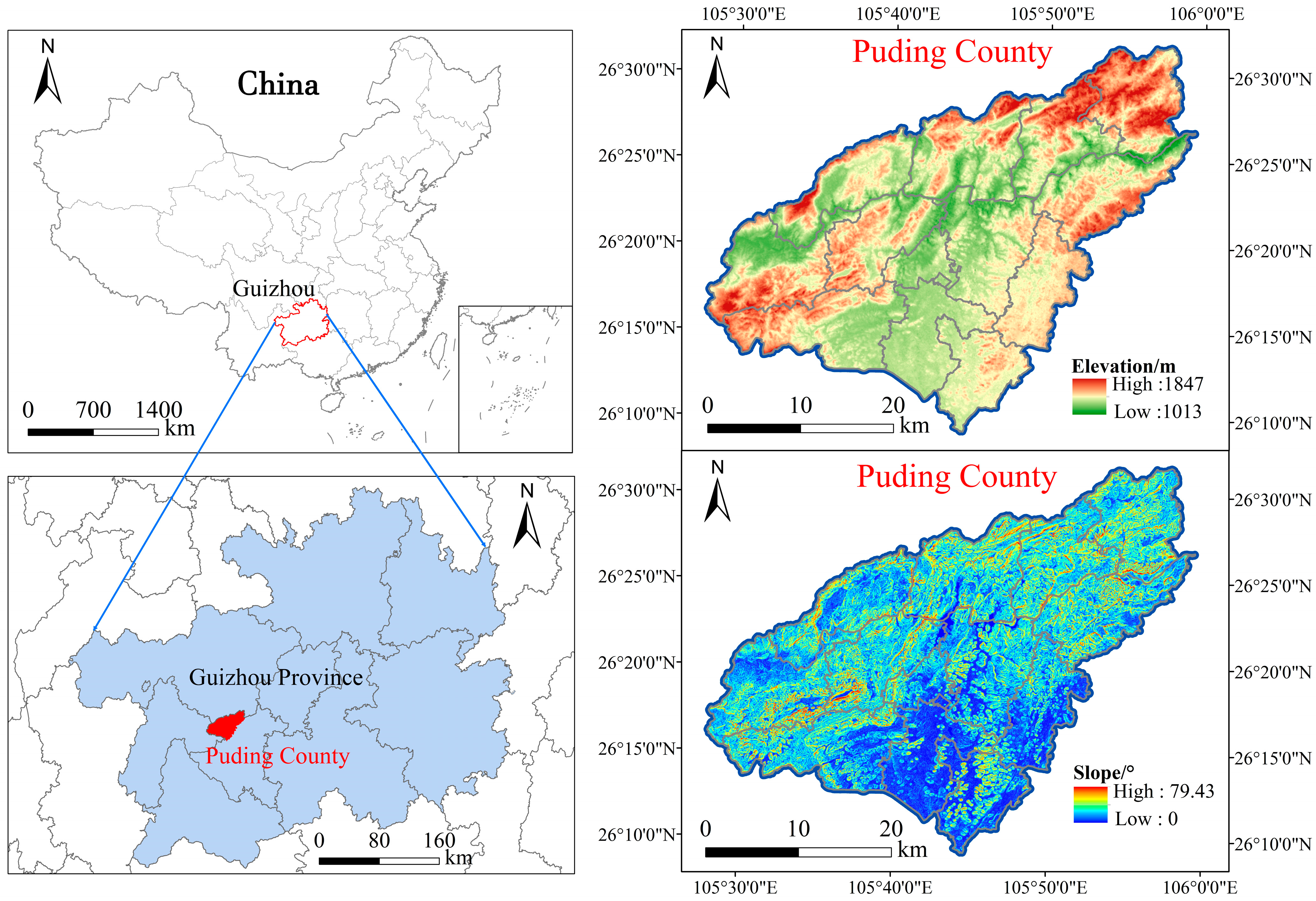
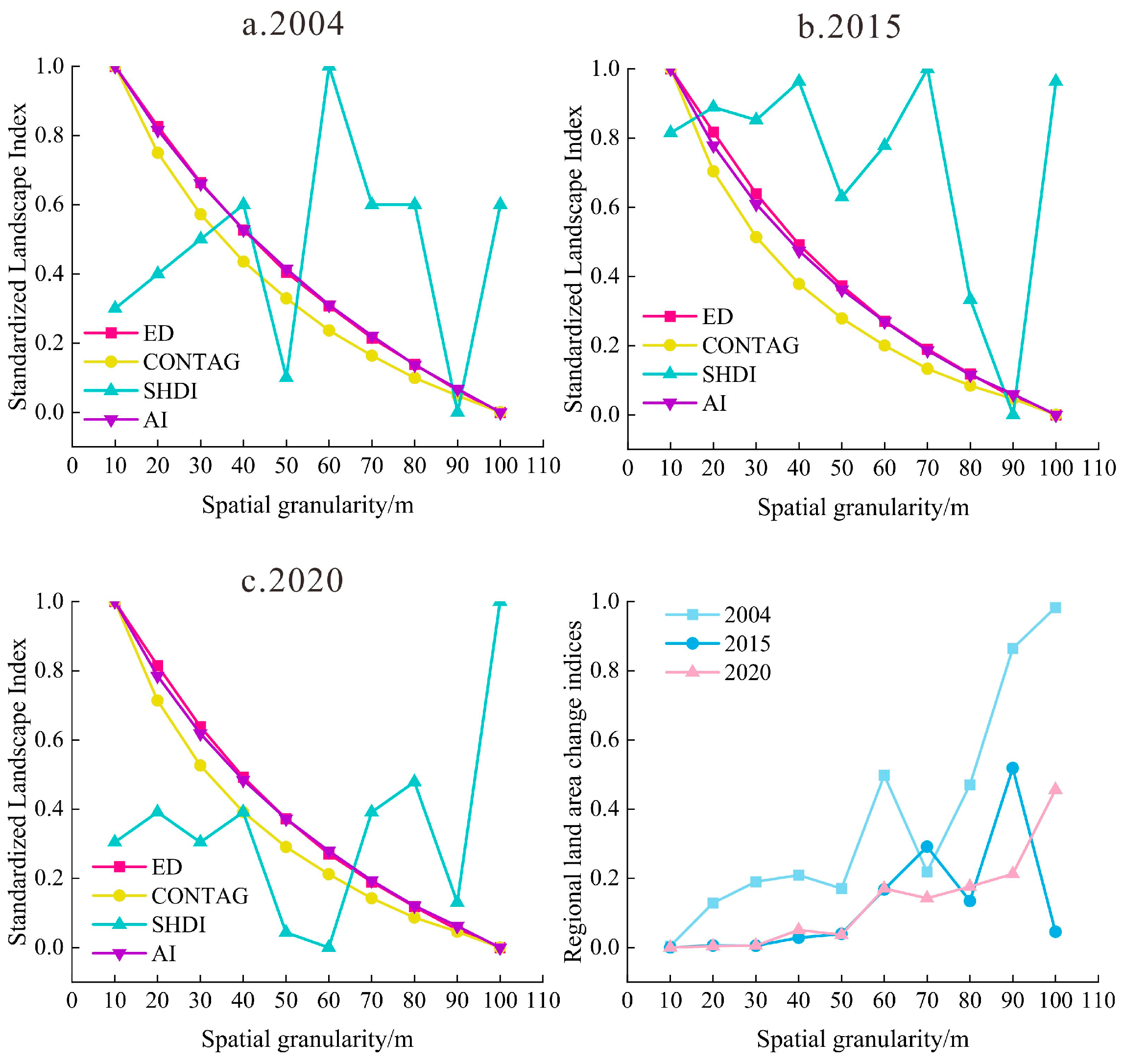

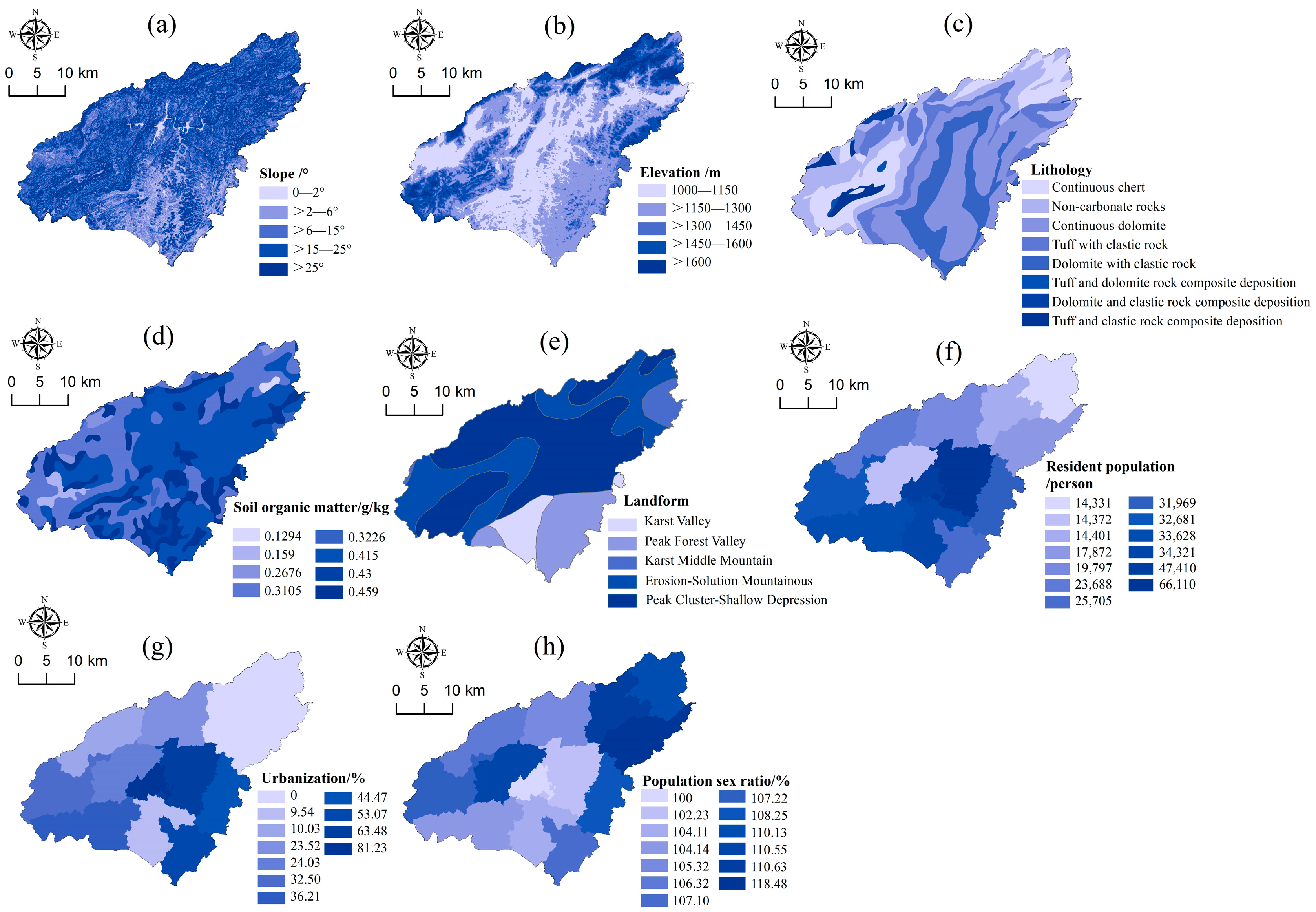
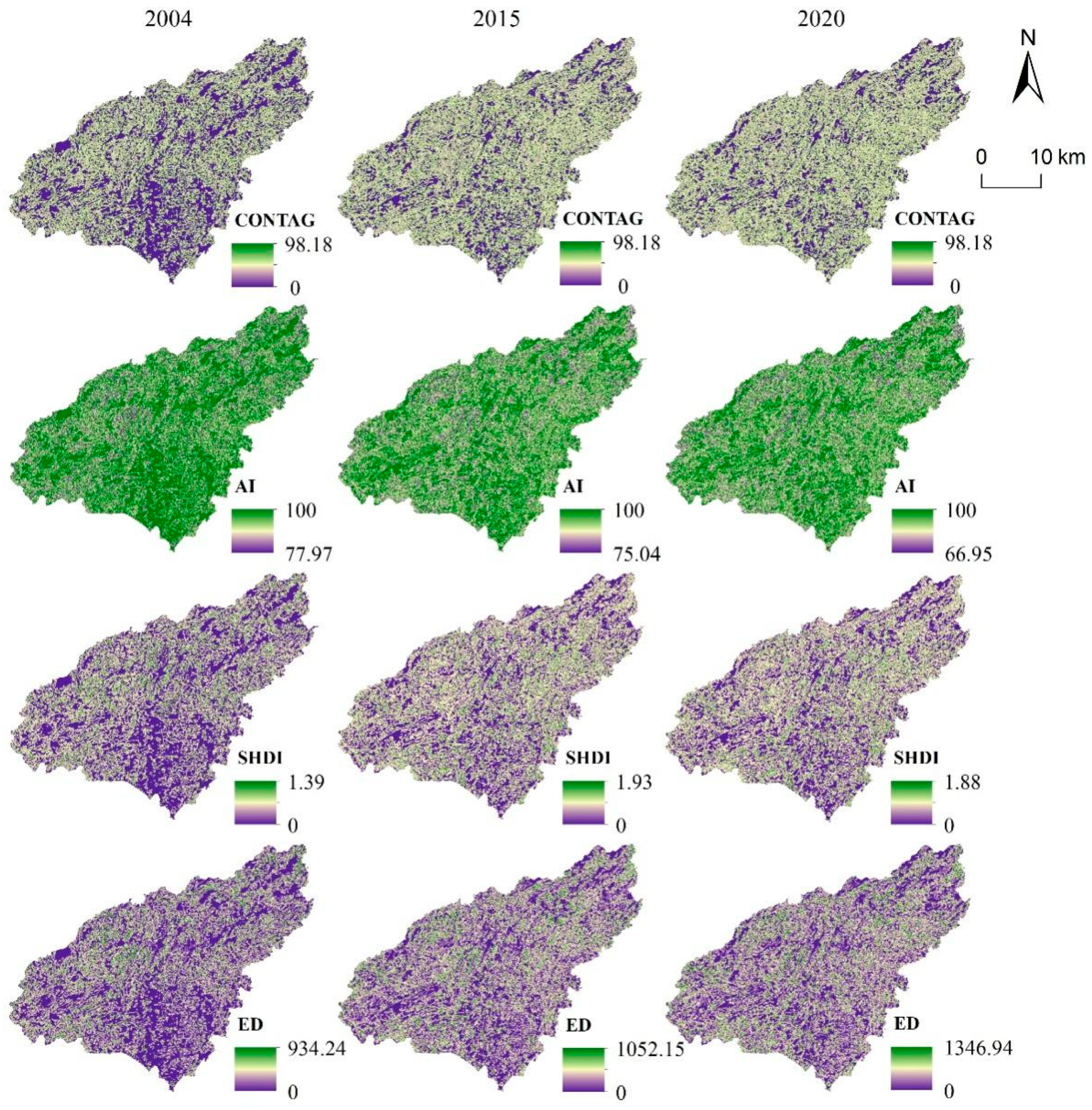
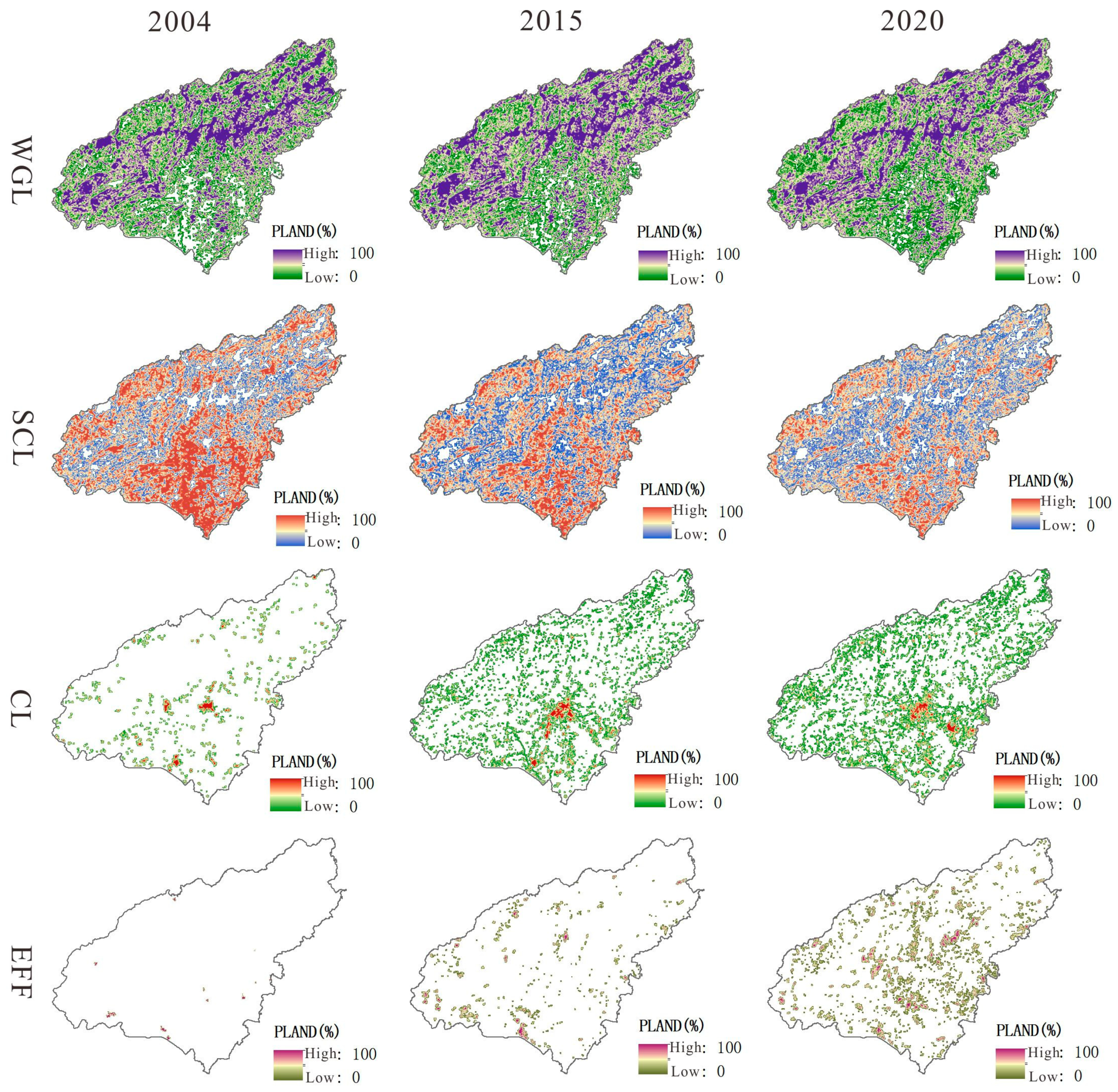
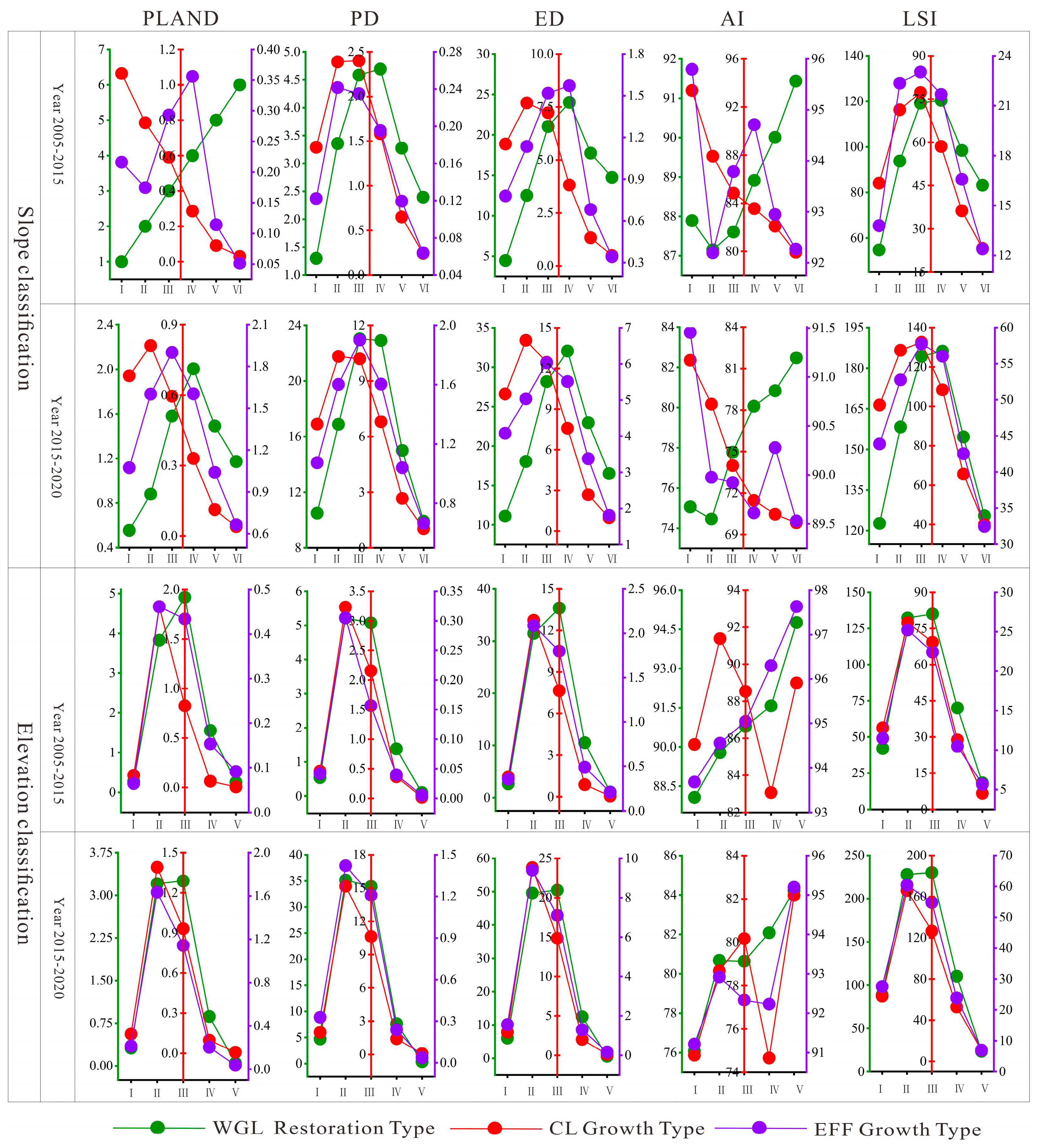

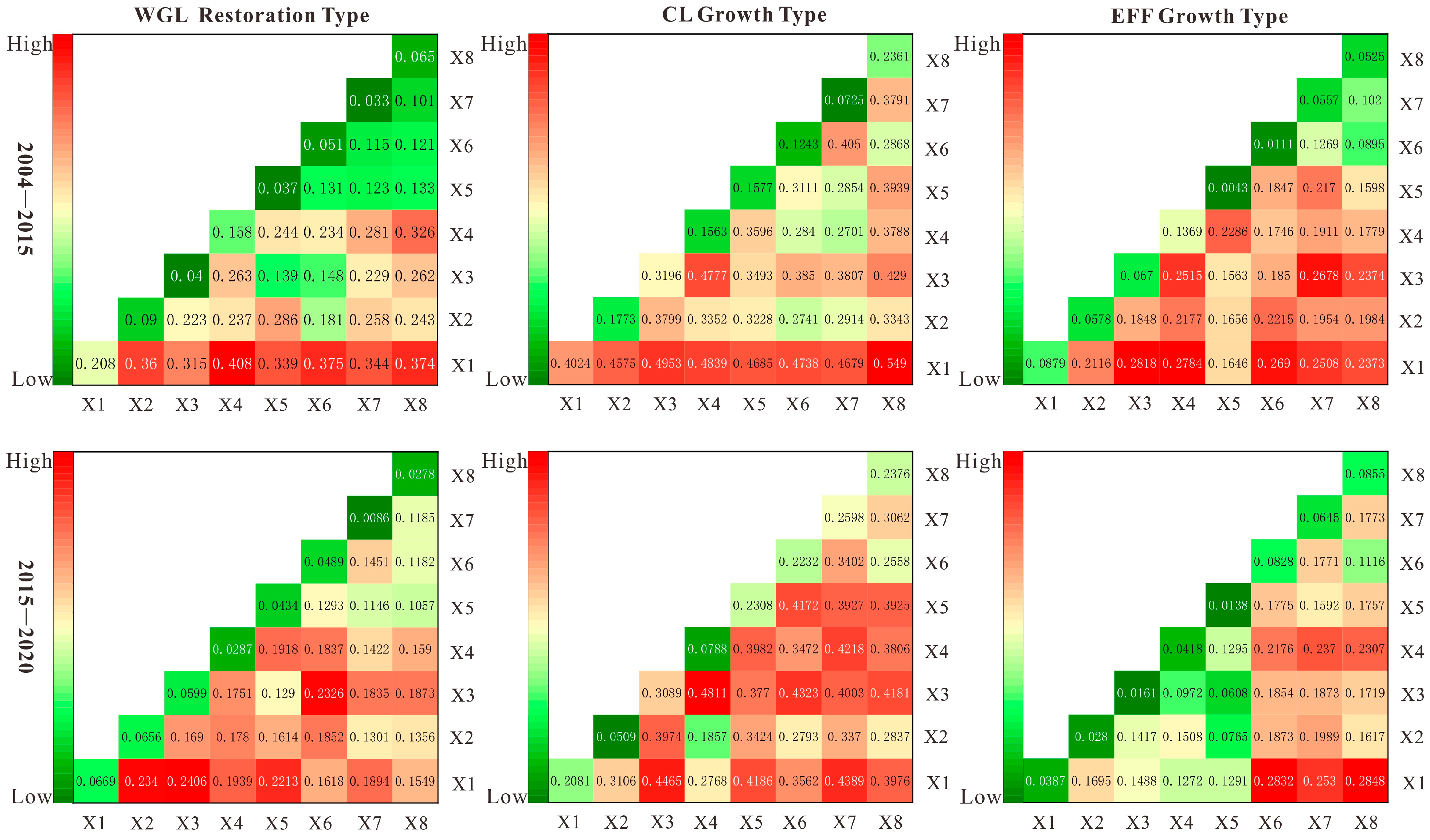
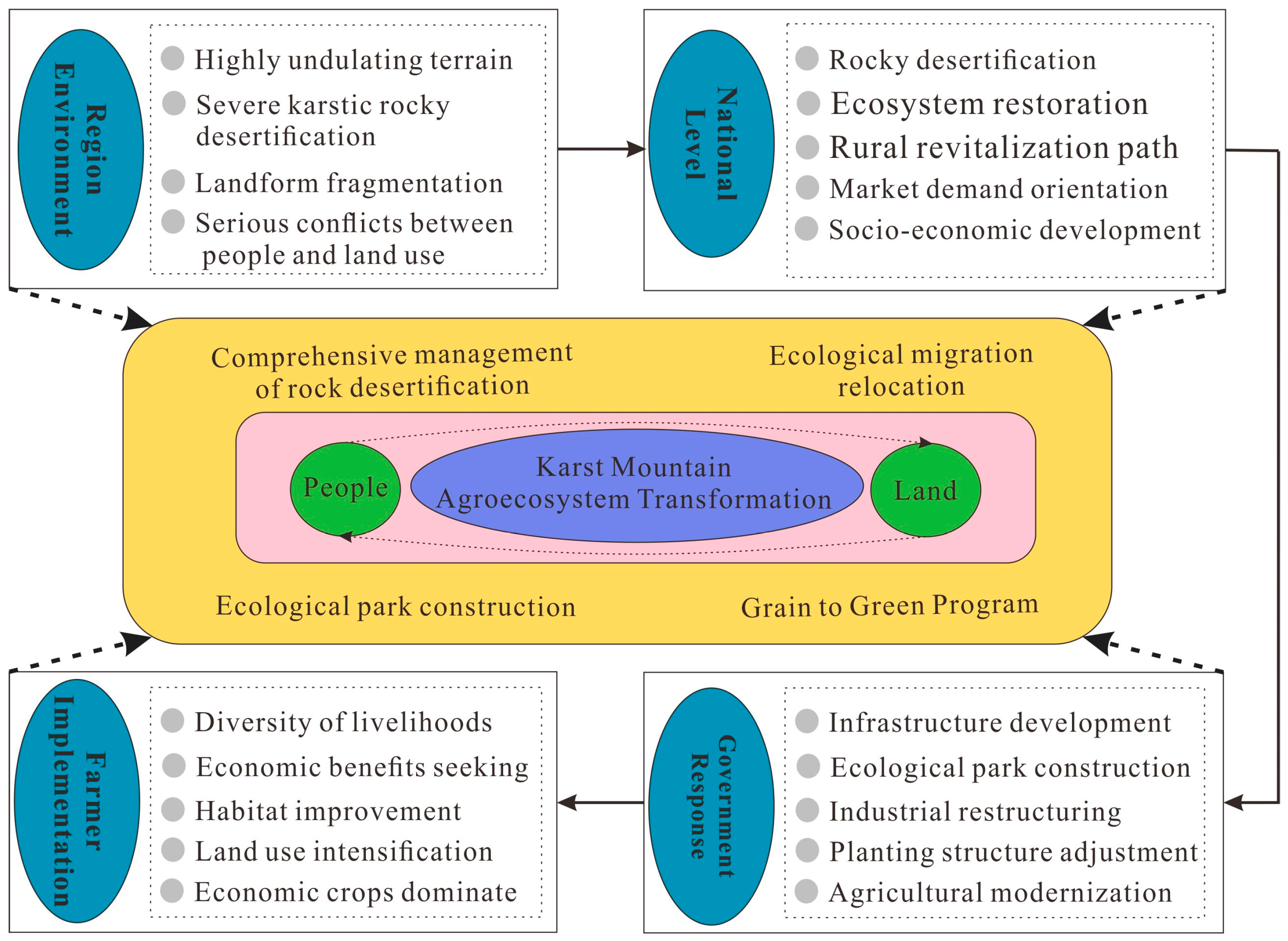
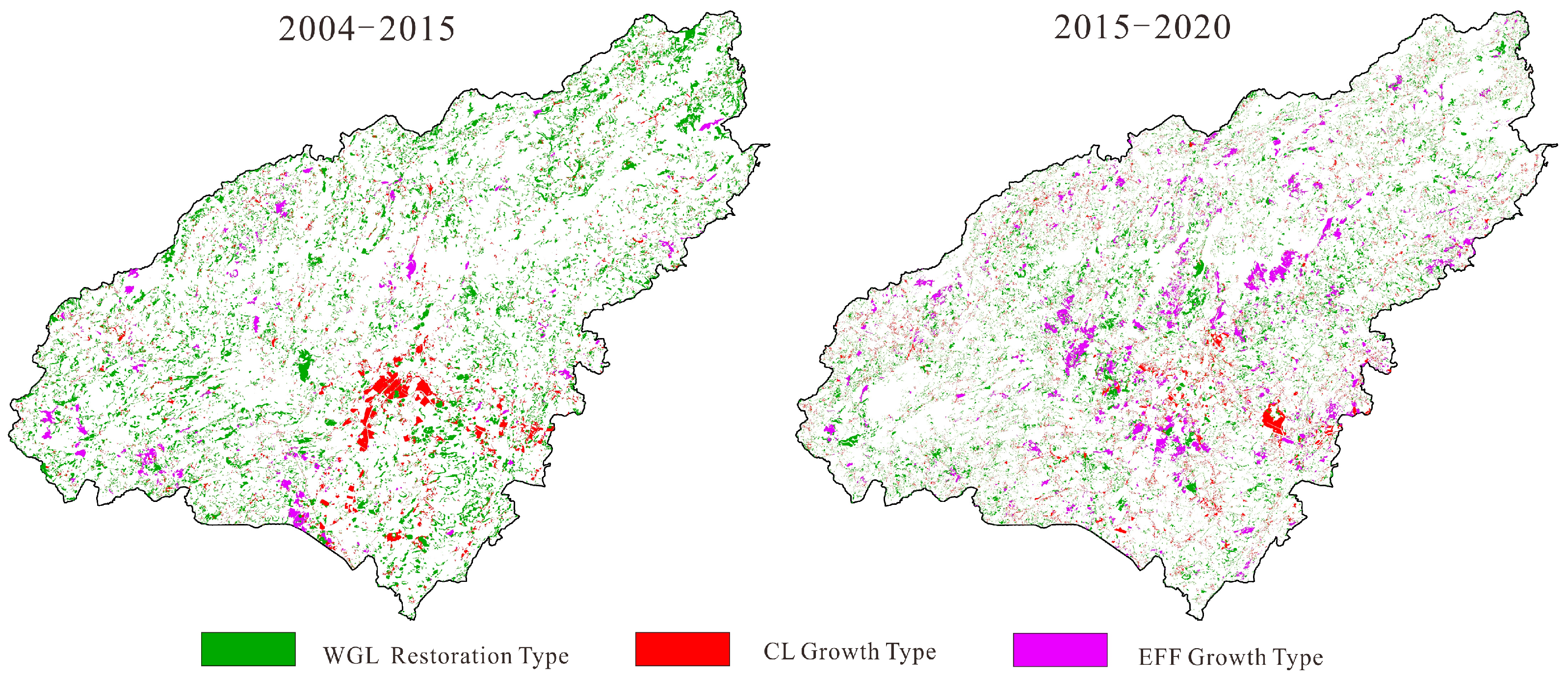

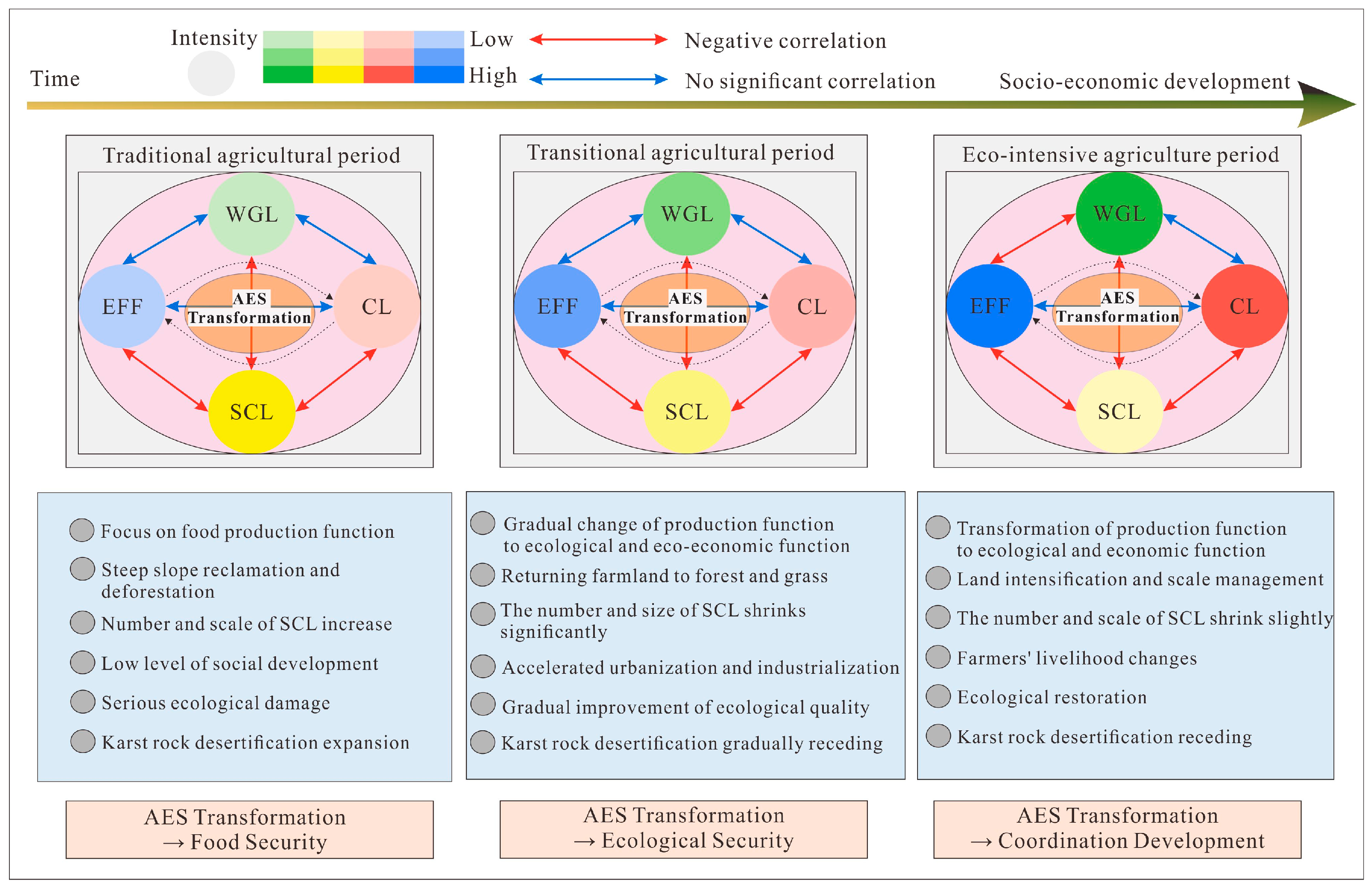
| Landscape Index | Mathematical Models | Meaning | Ecological Significance |
|---|---|---|---|
| landscape percentage (PLAND) | is the number of patches of landscape type , is the area of the th patch of landscape type , and is the total area of the landscape. The range of values: 0 ≤ ≤ 100 | Indicates the percentage of total landscape area accounted for by a particular landscape type and is one of the bases to help determine the dominant landscape element in the landscape. | |
| patch density (PD) | denotes the number of patches of a certain type in the landscape, denotes the area of patches of a certain type, and the formula denotes the number of patches per square kilometer. Range of values: > 0 | Reflects the degree of spatial heterogeneity of the landscape, and the fragmentation of landscape patches within agroecosystems. | |
| edge density (ED) | denotes the length of the boundary between the patches of landscape elements of category and the patches of adjacent landscape elements of category j in the landscape; denotes the total area of the landscape—unit: m/ha. | Reflects the edge length between heterogeneous landscape elements patches per unit area within the landscape. The larger the value, the more heterogeneous landscape patches and the more fragmented the landscape. | |
| shape index (LSI) | is the total length of the boundaries of all patches in the landscape; is the total area of the landscape. Range of values: ≥ 1 | When there is only one square patch in the landscape, = 1; when the plate shape in the landscape is irregular or deviates from the square, increases. | |
| agglomeration index (AI) | indicates the number of similar neighboring patches of the corresponding landscape patch type. Range of values: 0 < ≤ 100 | The length of the common boundary between the image elements of the patches judges the degree of aggregation and dispersion of the patches. The smaller the length of the common boundary among the image elements, the smaller the degree of aggregation; the larger the common boundary, the greater the degree of patch aggregation. |
| Years | CONTAG/% | AI */% | SHDI | ED * |
|---|---|---|---|---|
| 2004 | 60.1027 | 89.8187 | 1.1532 | 101.6691 |
| 2015 | 50.9482 | 84.9017 | 1.3268 | 150.8765 |
| 2020 | 47.0128 | 84.7106 | 1.4529 | 152.8342 |
Disclaimer/Publisher’s Note: The statements, opinions and data contained in all publications are solely those of the individual author(s) and contributor(s) and not of MDPI and/or the editor(s). MDPI and/or the editor(s) disclaim responsibility for any injury to people or property resulting from any ideas, methods, instructions or products referred to in the content. |
© 2023 by the authors. Licensee MDPI, Basel, Switzerland. This article is an open access article distributed under the terms and conditions of the Creative Commons Attribution (CC BY) license (https://creativecommons.org/licenses/by/4.0/).
Share and Cite
Yu, L.; Li, Y.; Yu, M.; Chen, M.; Yang, L. Dynamic Changes in Agroecosystem Landscape Patterns and Their Driving Mechanisms in Karst Mountainous Areas of Southwest China: The Case of Central Guizhou. Sustainability 2023, 15, 9160. https://doi.org/10.3390/su15129160
Yu L, Li Y, Yu M, Chen M, Yang L. Dynamic Changes in Agroecosystem Landscape Patterns and Their Driving Mechanisms in Karst Mountainous Areas of Southwest China: The Case of Central Guizhou. Sustainability. 2023; 15(12):9160. https://doi.org/10.3390/su15129160
Chicago/Turabian StyleYu, Limin, Yangbing Li, Meng Yu, Mei Chen, and Linyu Yang. 2023. "Dynamic Changes in Agroecosystem Landscape Patterns and Their Driving Mechanisms in Karst Mountainous Areas of Southwest China: The Case of Central Guizhou" Sustainability 15, no. 12: 9160. https://doi.org/10.3390/su15129160




